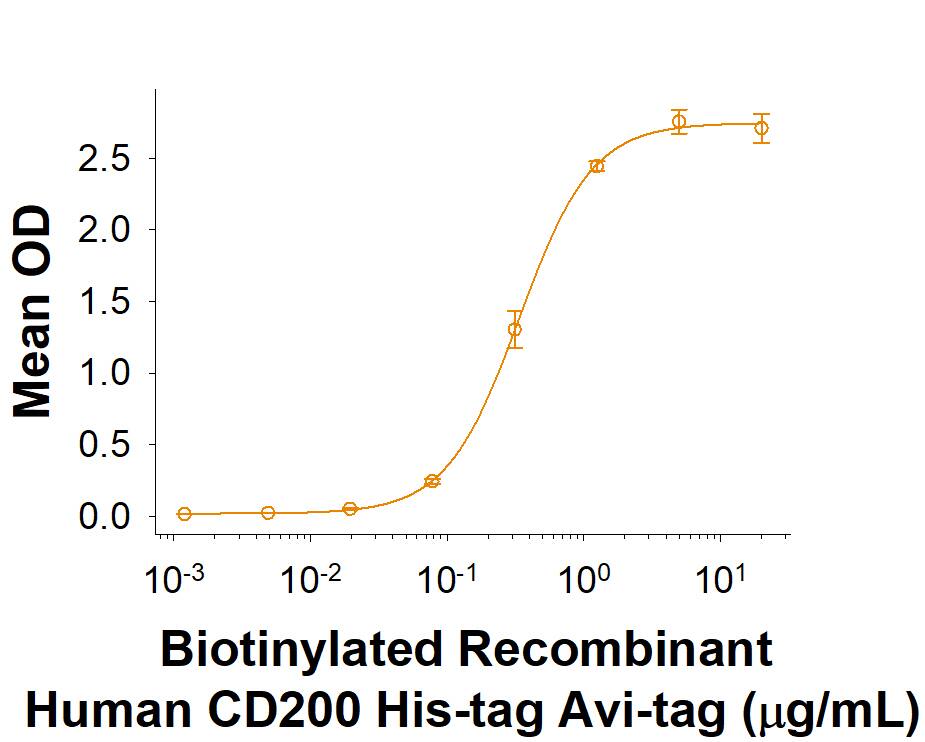Recombinant Human CD200 His-tag Avi-tag Protein, CF
R&D Systems, part of Bio-Techne | Catalog # AVI10032
Biotinylated

Key Product Details
Learn more about Avi-tag Biotinylated Proteins
Source
HEK293
Accession #
Structure / Form
Biotinylated via Avi-tag
Conjugate
Biotin
Applications
Bioactivity
Product Specifications
Source
Human embryonic kidney cell, HEK293-derived human CD200 protein
| Human CD200 (Gln31-Lys232) Accession # AAH22522.1 |
HHHHHH | Avi-tag |
| N-terminus | C-terminus |
Purity
>95%, by SDS-PAGE visualized with Silver Staining and quantitative densitometry by Coomassie® Blue Staining.
Endotoxin Level
<0.10 EU per 1 μg of the protein by the LAL method.
N-terminal Sequence Analysis
Gln31 inferred from enzymatic pyroglutamate treatment revealing Val32.
Predicted Molecular Mass
26 kDa
SDS-PAGE
40-50 kDa, under reducing conditions
Activity
The biotin to protein ratio is greater than 0.7 as determined by the HABA assay.
Measured by its binding ability in a functional ELISA.
When Recombinant Human CD200R1 Fc Chimera (Catalog # 3414-CD) is immobilized at 2 µg/mL (100 µL/well), Biotinylated Recombinant Human CD200 His-tag Avi-tag (Catalog # AVI10032) binds with an ED50 of 0.1-0.6 μg/mL.
Measured by its binding ability in a functional ELISA.
When Recombinant Human CD200R1 Fc Chimera (Catalog # 3414-CD) is immobilized at 2 µg/mL (100 µL/well), Biotinylated Recombinant Human CD200 His-tag Avi-tag (Catalog # AVI10032) binds with an ED50 of 0.1-0.6 μg/mL.
Scientific Data Images for Recombinant Human CD200 His-tag Avi-tag Protein, CF
When Recombinant Human CD200R1 Fc Chimera (3414-CD) is immobilized at 2 µg/mL (100 µL/well), Biotinylated Recombinant Human CD200 His-tag Avi-tag (Catalog # AVI10032) binds with an ED50 of 0.1-0.6 µg/mL.
2 μg/lane of Biotinylated Recombinant CD200 His-tag Avi-tag Protein (Catalog # AVI10032) was resolved with SDS-PAGE under reducing (R) and non-reducing (NR) conditions and visualized by Coomassie® Blue staining, showing bands at 40-50 kDa.
Formulation, Preparation and Storage
AVI10032
| Formulation | Lyophilized from a 0.2 μm filtered solution in PBS with Trehalose. |
| Reconstitution | Reconstitute at 500 μg/mL in PBS. |
| Shipping | The product is shipped at ambient temperature. Upon receipt, store it immediately at the temperature recommended below. |
| Stability & Storage | Use a manual defrost freezer and avoid repeated freeze-thaw cycles.
|
Background: CD200
References
- Gorczynski, R.M. (2005) Curr. Opin. Invest. Drugs 6:483.
- Barclay, A.N. et al. (2002) Trends Immunol. 23:285.
- McCaughan, G.W. et al. (1987) Immunogenetics 25:329.
- Chen, Z. et al. (2008) Transplantation. 86:1116
- Wright, G.J. et al. (2001) Immunology 102:173.
- Shiratori, I. et al. (2005) J. Immunol. 175:4441.
- Cherwinski, H.M. et al. (2005) J. Immunol. 174:1348.
- Fallarino, F. et al. (2004) J. Immunol. 173:3748.
- Hoek, R.M. et al. (2000) Science 290:1768.
- Hatherley, D. and A.N. Barclay (2004) Eur. J. Immunol. 34:1688.
- Jenmalm, M.C. et al. (2006) J. Immunol. 176:191.
- Borriello, F. et al. (1997) J. Immunol. 158:4548.
- Gorczynski, R. et al. (2004) J. Immunol. 172:7744.
- Hatherley, D. et al. (2005) J. Immunol. 175:2469.
- Foster-Cuevas, M. et al. (2004) J. Virol. 78:7667.
- Cameron, C.M. et al. (2005) J. Virol. 79:6052.
- Langlais, C.L. et al. (2006) J. Virol. 80:3098.
Alternate Names
CD200, MOX1, MOX2, MRC, OX-2
Gene Symbol
CD200
UniProt
Additional CD200 Products
Product Documents for Recombinant Human CD200 His-tag Avi-tag Protein, CF
Product Specific Notices for Recombinant Human CD200 His-tag Avi-tag Protein, CF
For research use only
